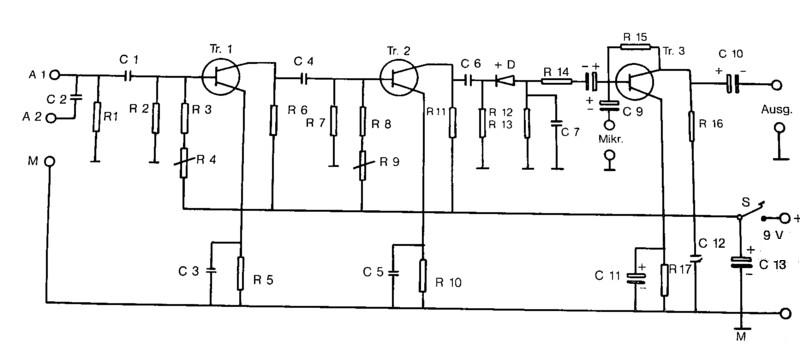Bridge between the Terrestrial and the Beyond
- Theory and Practice of Transcommunication -
by Hildegard Schaefer (†)
back to Book Content
11. Recording with the Psychofon
In the years from 1972 to 1974, Viennese engineer Franz Seidl (H1982) has developped an apparatus especially destined for the research on tape-recorded voices. He called it Psychofon. Later other engineers, technicians and laymen, too, have rebuilt this unit according to the circuit diagram released by Franz Seidl. Except of minor changes, the Psychofons built today correspond to the original construction and the results obtained with these do not differ from those obtained with the original model.
The Psychofon allows three recording methods at a time:
-
broad-band reception
-
self-sender method
-
microphone recording
With the broad-band method short-wave-, medium-wave- and long-wave broadcasts are simultaneously received, which means that the phenomenon is not limited to only one frequency – as it is with a current radio supported recording (pls. see also chapter 12: broad-band method).
The Self-sender is realized by the incorporation of a high-frequency oscillator active in the short-wave range. Its oscillations are mixed with the signals received with the broad-band reception. The effects are the making available of additional energy for acting as a carrier, plus the possibility of modulating independently from radio frequencies.
The signals received via the microphone are admixed to those from broad-band reception and self-sender. The total of these signals arrives at the “magnetic-tape” jack or the “tape recorder” jack (pls. see also “Recording with self-sender, page 46). After having connected this jack with that of the microphone of the recording unit, recording can begin. Simultaneous listening is possible via earphone.
When recording with Psychofon support, three types of paranormal voice manifestations can be obtained:
-
microphone voices, which generally are low
-
radio voices; they are louder and mostly transformations
-
self-sender voices; they, too, are loud, but differ from the other voices by
their tone colour and by longer messages.
In my first book I already reported on the Psychofon prototype according to Ing. Franz Seidl, but did not publish a circuit diagram because Mr. Seidl had done this in his own book (“Transzendentalstimmen” (transcendetal voices)).
Since a few years later Mr. Seidl made some improvements to his appliance and informed me of these, I present here below the modified circuit diagram, complete with detailed data so as to allow talented experimenters or experts the rebuilding of the unit.
|
 |
Resistors 0,25 W:
R 1, R 2: 12 kΩ
R 3: 6 kΩ
R 4: regulator 0,1 MΩ
R 5: 390 Ω
R 6: 820 Ω
R 7: 12 kΩ
R 8: 6 kΩ
R 9: regulator 0,1 MΩ
R 10: 390 Ω
R 11: 820 Ω
R 12, R 13: 47 kΩ
R 14: 6 kΩ
R 15: 100 kΩ
R 16: 12 kΩ
R 17: 300 Ω |
Condensors 16 V-:
C 1: 0,15 µF
C 2: 50 pF
C 3, 4, 5, 6, 12: 15 µF
C 7: 3 nF
C 8, 9, 10: 22 µF
C 11: 220 µF
C 13: 220 - 500 µF
The values of resistors and capacitors may vary around those indicated. |
Tr. 1, Tr. 2: like BF 310
Tr. 3: like BC 413
HF diode:
AA 116, 1 N148
A 1, A 2: antenna input
M: earth
Mikr.: microphone input
Ausg.: output to recorder
S: switch or R9 as a potentiometer with switch |
The jacks for antennas 1 and 2 are isolated to avoid short-circuits caused by the metal housing. Switch S for the battery may be expediently combined with a potentiometer instead of regulator R9. Jack Mikr. = microphone; the output is to be connected to the (magnetic) tape recorder’s input. The metal housing serves as a shielding and is connected to earth M, i.e., the negative pole of the battery.
Certainly, amateurs would need more profound and more detailed information for a perfect rebuilding of the Psychofon, such a description would however go clearly beyond a general retrospect on the already known classical recording methods. But further information can be placed at the disposal of every interested person.
Recording with self-sender
This method has been developped by Prof. Alex Schneider,
St. Gallen ,
Switzerland
, in cooperation with Dr. Konstantin Raudive. It has proved with Dr. Raudive as well as with other experimenters. This method supplies carriers excluding the registering of words or scraps of words that might lead to misinterpretation. The effect of the self-sender stage is that energy is made available which simultaneously serves as a carrier and which is modulated independently from radio frequencies.
The paranormal fade-ins feature the same characteristics as are noticed with other methods. CBistes will not have any problems with the self-sender method.
back to Top of Page
|
You are visiting our website: W rld ITC.org To reach our homepage click here please. rld ITC.org To reach our homepage click here please. |
